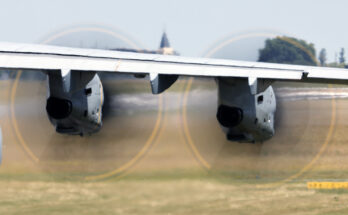by C. Zachary Hofer, Electronic Systems Analyst, Forecast International.
It’s official. The U.S. Air Force has taken formal steps to implement its stated intention to abandon the JSTARS Recap program. In the Department of Defense’s recently released forecast year 2019 budget documents, all requests for funding related to JSTARS Recap research, development, testing, and evaluation were dropped, with FY18’s budget of $417.2 million reduced to nothing.
The decision once again negates years of planning and funding to replace the Air Force’s aging Boeing 707-based E-8 Joint Surveillance Target Attack Radar System (JSTARS) aircraft. Since 2015, the start of the latest iteration of a JSTARS replacement program, and including FY18 approvals, over $650 million has been earmarked for the JSTARS Recap. By canceling the program, the Air Force has decidedly walked away from a large amount of spending. However, the service will be walking away not only from the sizable sum that has been spent to date, but also from an enormous obligation in future spending.
The JSTARS Recap was expected to cost over $6.9 billion from 2018 through 2027 alone. Certainly, as it has in past attempts to replace JSTARS, the Air Force has, some might say, wasted a great deal of previous funding, but the service will also have saved nearly $7 billion over the next 10 years. While this will save the U.S. government a considerable amount of money, it also means a huge loss to JSTARS Recap competitors Boeing, Lockheed Martin, and Northrop Grumman.
Due to evolving Air Force needs as the service adapts to the modern asymmetric battlefield, the concept of a large, centralized system like the JSTARS has, the service implied through recent statements, become archaic. A modern, networked approach would be more efficient, provide a wider field of view, and be more adaptable.
To this end, the Air Force will approach a widely networked, distributed awareness solution that will provide the information and capability that otherwise would come from a replacement JSTARS platform. The Air Force plans to integrate data from sensors on other aircraft, including manned platforms like the F-35 and unmanned aircraft like the MQ-9 Reaper. In the short term, this means utilizing existing sensors. In the future it means potentially integrating new sensors on board existing platforms. According to statements from Air Force officials, this also means that E-3 AWACS aircraft will receive an influx of modernization funding, and that the current E-8 JSTARS will be funded and modernized to provide relevant capability well into the 2020s.
Please feel free to use this content with Forecast International and analyst attributions, along with a link to the article. Contact Ray Peterson at +1 (203) 426-0800 or via email at ray.peterson@forecast1.com for additional analysis.
Forecast International’s Electronic Systems Market Intelligence Services provides full reports on the ALQ-99 and the NGJ. The Platinum Forecast System adds deeper, hourly-updated access to funding and production forecasts, as well as the system level reports. An updated report on the ALQ-99 program was released in the March Airborne Electronics Forecast supplement.
For 50 years, Forecast International intelligence reports have been the aerospace and defense industry standard for accurate research, analysis, and projections. Our experienced analysts compile, evaluate, and present accurate data for decision makers. FI's market research reports offer concise analysis of individual programs and identify market opportunities. Each report includes a program overview, detailed statistics, recent developments and a competitive analysis, culminating in production forecasts spanning 10 or 15 years. Let our market intelligence reports be a key part of reducing uncertainties and mastering your specific market and its growth potential. Find out more at www.forecastinternational.com




